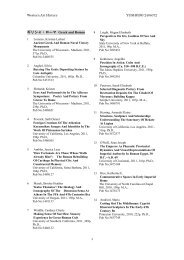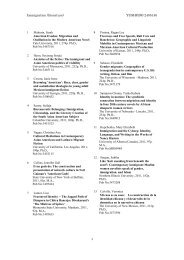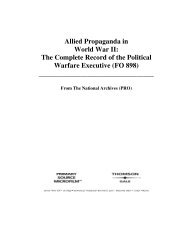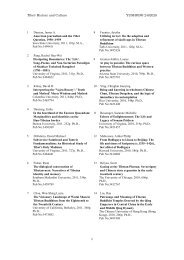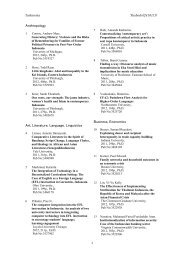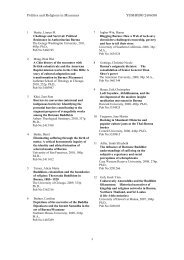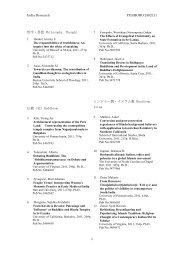Section 2 Consolidated financial statements Section 2 Consolidated ...
Section 2 Consolidated financial statements Section 2 Consolidated ...
Section 2 Consolidated financial statements Section 2 Consolidated ...
Create successful ePaper yourself
Turn your PDF publications into a flip-book with our unique Google optimized e-Paper software.
Chapter 3 IFRSs US GAAP Chapter 3<br />
<strong>Section</strong> 2<br />
<strong>Consolidated</strong> <strong>financial</strong><br />
<strong>statements</strong><br />
<strong>Section</strong> 2<br />
<strong>Consolidated</strong> <strong>financial</strong><br />
<strong>statements</strong><br />
2.1 AUTHORITATIVE PRONOUNCEMENTS 2.1 AUTHORITATIVE PRONOUNCEMENTS<br />
• IFRS 3<br />
• IAS 27<br />
• IAS 31<br />
• IAS 32<br />
• SIC-12<br />
• FAS 94<br />
• FAS 140<br />
• FAS 144<br />
• ARB 43, Chapter 12<br />
• ARB 51<br />
• APB 18<br />
• FIN 46(R)<br />
COMMENT<br />
The IASB is engaged in two projects – Business Combinations (Phase II) and<br />
Consolidation – that will impact the accounting treatment of subsidiaries. Phase II<br />
of the Business Combinations project on application of the purchase method is<br />
conducted jointly with the FASB. An Exposure Draft is expected in 2005 (with an<br />
IFRS to follow later in that year, likely to be effective for periods beginning on or<br />
after 1 January 2007). Application is expected to be prospective, with the inclusion<br />
of special transitional arrangements. The Business Combinations Project Phase II<br />
proposes, inter alia, that:<br />
• consolidated goodwill would include the minority’s share of goodwill;<br />
• the minority would bear their proportionate share of losses, even if these<br />
reduced the minority interest (to be known as non-controlling interest) below<br />
zero; and<br />
• transactions between majority and minority shareholders, not resulting in a<br />
loss of control over the subsidiary, would be treated as equity transactions<br />
not giving rise to a profit or loss.<br />
The Consolidation Project will lead to a new IFRS to replace IAS 27 <strong>Consolidated</strong><br />
and Separate Financial Statements and SIC-12 Consolidation – Special Purpose<br />
Entities. It is likely to contain significant changes to the criteria giving rise to a<br />
presumption of control. This is discussed further in sections 2.3 and 2.6.<br />
COMMENT<br />
Consolidations have been on the FASB’s agenda for almost 20 years and a final<br />
Statement was planned but in January 2001, the FASB determined that there was<br />
not sufficient Board member support to proceed.<br />
The Board issued FIN 46 Consolidation of Variable Interest Entities an<br />
interpretation of ARB 51 in January 2003 (revised December 2003). FIN 46(R)<br />
introduces a new consolidation model—the variable interests model which provides<br />
guidance on how to apply the controlling <strong>financial</strong> interest criteria in ARB 51 to<br />
variable interest entities. See section 2.7.<br />
Currently, the FASB is partnering with the IASB on a joint project that represents<br />
the second phase of the Board’s overall project on business combinations –<br />
reconsidering aspects of the purchase method of accounting that were not<br />
deliberated in FAS 141 and FAS 142. Phase II will revise FAS 141 to require all<br />
acquisitions of businesses to be measured at the fair value of the business acquired<br />
and provide specific guidance for applying the purchase method. The FASB issued<br />
a summary of tentative decisions on phase II of the business combinations project<br />
as of July 2004. The FASB and IASB are developing common exposure drafts of<br />
proposed standards which are expected to be issued in the first half of 2005.<br />
IAS 27.1,9,12<br />
IAS 27.10<br />
2.2 CONSOLIDATION POLICY 2.2 CONSOLIDATION POLICY<br />
A parent company shall prepare consolidated <strong>financial</strong> <strong>statements</strong> in which all<br />
subsidiaries are consolidated.<br />
A parent company need not prepare consolidated <strong>financial</strong> <strong>statements</strong> if and only if:<br />
• it is a wholly owned subsidiary itself (or is a partially-owned subsidiary, and its<br />
other owners, including those not entitled to vote, have been informed about,<br />
and do not object to, the parent company not presenting consolidated<br />
<strong>financial</strong> <strong>statements</strong>);<br />
• the parent’s debt or equity instruments are not traded in a public market;<br />
• the parent did not file, nor is in the process of filing, its <strong>financial</strong> <strong>statements</strong><br />
with a securities commission or other regulatory organisation for the purpose<br />
of issuing any class of instruments in a public market; and<br />
If an enterprise has one or more subsidiaries, consolidated <strong>statements</strong> rather than<br />
parent company <strong>financial</strong> <strong>statements</strong> are the appropriate general-purpose <strong>financial</strong><br />
<strong>statements</strong>.<br />
There is a presumption that consolidated <strong>statements</strong> are more meaningful than<br />
separate <strong>statements</strong> and that they are usually necessary for fair presentation when<br />
one company has an indirect or direct controlling <strong>financial</strong> interest in one or more<br />
other companies.<br />
Equity accounting is not a valid substitute for consolidation.<br />
FAS 94.61<br />
ARB 51.1<br />
FAS 94.15(c)<br />
142 143
Chapter 3: <strong>Section</strong> 2 <strong>Consolidated</strong> <strong>financial</strong> <strong>statements</strong> – IFRSs US GAAP – <strong>Consolidated</strong> <strong>financial</strong> <strong>statements</strong> Chapter 3: <strong>Section</strong> 2<br />
IAS 27.30<br />
IFRS 3.Appx A<br />
IAS 27.12<br />
• the ultimate or any intermediate parent of the parent produces consolidated<br />
<strong>financial</strong> <strong>statements</strong> available for public use that comply with International<br />
Financial Reporting Standards.<br />
A subsidiary is consolidated from its date of acquisition, the date on which the<br />
acquirer effectively obtains control, until the entity ceases to have control.<br />
Where a subsidiary is classified as held for sale under IFRS 5 Non-current Assets<br />
Held for Sale and Discontinued Operations, the results and net assets of the<br />
subsidiary are consolidated but the subsidiary is measured, presented and disclosed<br />
in accordance with IFRS 5 (see section 1.9).<br />
IAS 27.4,IG2,IG4<br />
IAS 27.13<br />
IAS 27.14-15<br />
IAS 27.IG1-IG8<br />
2.3 DEFINITION OF A SUBSIDIARY 2.3 DEFINITION OF A SUBSIDIARY<br />
A subsidiary is an entity (including an unincorporated entity) that is controlled by<br />
another entity, the parent. The parent has control when it has the power to govern<br />
the <strong>financial</strong> and operating policies of an entity so as to obtain benefits from its<br />
activities. It may be active or passive in nature and only one party will be the parent.<br />
Control exists when the parent holds:<br />
• directly or indirectly through subsidiaries, more than half of the voting power<br />
of an entity unless, in exceptional circumstances, it can be clearly<br />
demonstrated that such ownership does not constitute control;<br />
• power over more than one half of the voting rights by virtue of an agreement<br />
with other investors;<br />
• power to govern the <strong>financial</strong> and operating policies of the entity under a<br />
statute or an agreement;<br />
• power to appoint or remove the majority of the members of the board of<br />
directors or equivalent governing body; or<br />
• power to cast the majority of votes at meetings of the board of directors or<br />
equivalent governing body.<br />
COMMENT<br />
The IASB is engaged in a Consolidation Project will lead to a new IFRS to replace<br />
IAS 27 and SIC-12. It is likely to contain significant changes to the criteria giving<br />
rise to a presumption of control. The IASB has tentatively agreed that control<br />
should be based on satisfaction of all of the following:<br />
• power criterion – the ability to set strategic direction and to direct operating<br />
policy and strategy. In particular, the IASB have tentatively agreed that<br />
there should be a rebuttable presumption that the holdings of de facto agents<br />
of the company (such as senior employees, related parties etc) are available to<br />
the entity in assessing the power criterion. There will also be additional<br />
clarification on potential voting rights;<br />
• benefit criterion – the ability to access benefits; and<br />
• the link – the ability to use power so as to protect or maintain benefits.<br />
The existence and effect of potential voting rights (e.g. those arising from the<br />
exercise of share options or conversion of convertible debt or equity) that are<br />
currently exercisable or currently convertible are also considered when assessing<br />
whether an entity controls another entity. Potential voting rights are not currently<br />
exercisable or currently convertible when they cannot be exercised or converted<br />
‘Subsidiary’ refers to a corporation that is controlled, directly or indirectly, by<br />
another corporation. The usual condition for control is ownership of a majority<br />
(over 50%) of the outstanding voting stock. However, the power to control may<br />
also exist with a lesser percentage of ownership, for example, by contract, lease, and<br />
agreement with other stockholders or by court decree. This definition excludes<br />
entities that are controlled through only significant minority ownership of the<br />
outstanding voting stock.<br />
A<br />
SEC registrants<br />
In its rules on consolidation policy, the SEC emphasises the need to consider<br />
substance over form to determine the appropriate consolidation policy. The SEC<br />
notes that there may be situations where consolidation of an entity, notwithstanding<br />
the lack of technical majority ownership, is necessary to present fairly the <strong>financial</strong><br />
position and results of operations of the registrant, because of the existence of a<br />
parent/subsidiary relationship by means other than record, i.e. greater than 50%,<br />
ownership of voting stock.<br />
The definition of a subsidiary contained in Regulation S-X is based on control and<br />
risk:<br />
• Subsidiary – a subsidiary of a specified person is an affiliate (individual,<br />
corporation, partnership, trust or unincorporated organisation) controlled by<br />
such person directly or indirectly through one or more intermediaries.<br />
• Control – means the possession, direct or indirect, of the power to direct or<br />
cause the direction of management and policies of a person, whether through<br />
the ownership of voting shares, by contract or otherwise.<br />
• Voting shares – means the sum of all rights to vote for the election of<br />
directors.<br />
An entity may establish a controlling <strong>financial</strong> interest in another entity with little or<br />
no equity investment through either a nominee structure or other contractual<br />
arrangement. EITF 97-2 relates to contractual arrangements between physician<br />
practices and entities established to manage the operations of those practices but the<br />
SEC has concluded that the guidance should be applied to similar arrangements in<br />
other industries. Under the consensus, if all of the following requirements are met,<br />
then the management entity (entity ‘A’) has a controlling <strong>financial</strong> interest in the<br />
physician practice (entity ‘B’):<br />
APB 18.3(c)<br />
S-X 3A-02(a)<br />
S-X 1-02(x)<br />
S-X 1-02(g)<br />
S-X 1-02(z)<br />
EITF 97-2<br />
144 145
Chapter 3: <strong>Section</strong> 2 <strong>Consolidated</strong> <strong>financial</strong> <strong>statements</strong> – IFRSs US GAAP – <strong>Consolidated</strong> <strong>financial</strong> <strong>statements</strong> Chapter 3: <strong>Section</strong> 2<br />
until a future date or upon the occurrence of a future event. All potential voting<br />
rights should be considered, including potential voting rights held by other entities.<br />
All facts and circumstances should be considered including the terms of exercise of<br />
the potential voting rights and possible linked transactions. However, in making<br />
the assessment the intention of management and the <strong>financial</strong> ability to exercise or<br />
convert should not be taken into account.<br />
• The arrangement term is either (a) the entire remaining legal life of entity A or<br />
(b) a period of 10 years or more; and is not terminable by entity B except in<br />
the case of gross negligence, fraud, or other illegal acts by entity A.<br />
• Entity A Controls all major, or central operations of entity B including<br />
employee selection, hiring and firing and compensation arrangements.<br />
• Entity A has a significant <strong>financial</strong> interest in entity B that is (a) unilaterally<br />
saleable or transferable; and (b) provides entity A with the right to receive<br />
income in an amount that fluctuates based on the performance, and therefore<br />
fair value, of entity B.<br />
Based on this guidance, a contractual arrangement with a term of less than 10 years<br />
may not establish a controlling <strong>financial</strong> interest.<br />
IAS 27.12,19<br />
2.4 EXCLUSION OF SUBSIDIARIES FROM CONSOLIDATED<br />
FINANCIAL STATEMENTS<br />
<strong>Consolidated</strong> <strong>financial</strong> <strong>statements</strong> include all subsidiaries. A subsidiary is not<br />
excluded from consolidation simply because the investor is a venture capital<br />
organisation, mutual fund, unit trust or similar entity.<br />
Where a subsidiary is classified as held for sale under IFRS 5 Non-current Assets<br />
Held for Sale and Discontinued Operations, the results and net assets of the<br />
subsidiary are consolidated but the subsidiary is measured, presented and disclosed<br />
in accordance with IFRS 5 (see section 1.9).<br />
2.4 EXCLUSION OF SUBSIDIARIES FROM CONSOLIDATED<br />
FINANCIAL STATEMENTS<br />
Consolidation is required of all majority-owned subsidiaries, i.e. all companies in<br />
which a parent has a controlling <strong>financial</strong> interest directly or indirectly, except:<br />
• if control does not rest with the majority owner; or<br />
• if the subsidiary operates under foreign exchange restrictions, controls or<br />
other governmental imposed uncertainties which cast significant doubt on the<br />
parent’s ability to control the subsidiary.<br />
The exemption from consolidation where control is likely to be temporary, in<br />
ARB 51 <strong>Consolidated</strong> Financial Statements, as amended by FAS 94 Consolidation<br />
of All Majority-Owned Subsidiaries an amendment of ARB No. 51, with related<br />
amendments of APB Opinion No. 18 and ARB No. 43, Chapter 12, was removed<br />
by FAS 144 Accounting for the Impairment or Disposal of Long-Lived Assets. All<br />
long-lived assets or groups of assets classified as held for sale, even where recently<br />
acquired, should be recorded at the lower of carrying amount or fair value less cost<br />
to sell. FAS 144 also requires the results of operations classified as held for sale to<br />
be recognised in the period in which those operations occur.<br />
FAS 144 governs the accounting for all planned dispositions of operations,<br />
including planned dispositions of subsidiaries and supersedes APB 30 Reporting the<br />
Results of Operations – Reporting the Effects of Disposal of a Segment of a<br />
Business, and Extraordinary, Unusual and Infrequently Occurring Events and<br />
Transactions (see section 1).<br />
The presumption that all majority-owned investees should be consolidated may be<br />
overcome in cases where the minority shareholders have substantive participating<br />
rights that allow the minority shareholders to select management and establish<br />
operating and capital decisions of the investee.<br />
FAS 94.13<br />
FAS 144.App C2<br />
FAS 144.App B87<br />
EITF 96-16<br />
2.4.1 Unconsolidated subsidiaries 2.4.1 Unconsolidated subsidiaries<br />
IAS 27.12 <strong>Consolidated</strong> <strong>financial</strong> <strong>statements</strong> include all subsidiaries. The equity method should not be used as a substitute for consolidation. However,<br />
the equity method will generally be appropriate when conditions under which a<br />
subsidiary would not be consolidated prevail – namely where the investee is in legal<br />
reorganisation, bankruptcy or operates under foreign exchange restrictions etc.<br />
APB 18.14 fn4<br />
FAS 94.15(c)<br />
146 147
Chapter 3: <strong>Section</strong> 2 <strong>Consolidated</strong> <strong>financial</strong> <strong>statements</strong> – IFRSs US GAAP – <strong>Consolidated</strong> <strong>financial</strong> <strong>statements</strong> Chapter 3: <strong>Section</strong> 2<br />
IAS 27.22<br />
IAS 27.24-25<br />
IAS 27.22<br />
IAS 27.26-27<br />
IAS 21.46<br />
IAS 27.28<br />
IAS 32.33<br />
2.5 CONSOLIDATION PROCEDURES 2.5 CONSOLIDATION PROCEDURES<br />
2.5.1 Intragroup transactions 2.5.1 Intragroup transactions<br />
Preparation of consolidated <strong>financial</strong> <strong>statements</strong> requires the <strong>financial</strong> <strong>statements</strong> of<br />
the parent and its subsidiaries to be combined on a line-by-line basis by adding<br />
together like items of assets, liabilities, equity, income and expenses. In order to<br />
present <strong>financial</strong> information about the group as if it were that of a single economic<br />
entity, the following adjustments are required.<br />
Intragroup balances, transactions, income and expenses and profits and losses<br />
arising from intragroup transactions must be eliminated in full. Intragroup losses<br />
may indicate that the asset involved is impaired.<br />
The carrying amount of the parent’s investment in each subsidiary and the parent’s<br />
portion of equity of each subsidiary must be eliminated, and the minority interests in<br />
the profit or loss for the period and net assets of the subsidiary identified (see<br />
section 2.5.5). The treatment of goodwill or the excess of the acquirer’s interest in<br />
the net fair value of the acquiree’s identifiable assets, liabilities and contingent<br />
liabilities is dealt with in IFRS 3 Business Combinations (see section 3).<br />
ARB 51 <strong>Consolidated</strong> Financial Statements requires complete elimination of<br />
intragroup profits or losses on assets remaining within the group.<br />
Elimination is also required of:<br />
• intragroup items and transactions between entities included in consolidated<br />
<strong>financial</strong> <strong>statements</strong>; as well as<br />
• unrealised profits and losses on transactions between entities in the group and<br />
those which are accounted for under the equity method.<br />
If such eliminations are not made, an explanation of the reasons and the treatment<br />
of those transactions should be disclosed.<br />
The amount of intragroup items and transactions is not affected by the existence of<br />
a minority interest. However, the complete elimination of the profit or loss may<br />
be allocated proportionately between the majority (group) and minority interests.<br />
2.5.2 Non‐coterminous <strong>financial</strong> <strong>statements</strong> 2.5.2 Non‐coterminous <strong>financial</strong> <strong>statements</strong><br />
When the <strong>financial</strong> <strong>statements</strong> of a subsidiary are drawn up to a different reporting<br />
date from that of the parent, additional <strong>financial</strong> <strong>statements</strong> should be prepared by<br />
the subsidiary drawn up to the parent’s reporting date. If this is impracticable, the<br />
<strong>financial</strong> <strong>statements</strong> of the subsidiary at a different date may be used (so long as the<br />
difference between the reporting dates is no more than three months, and the length<br />
of the reporting periods and any difference in reporting dates is the same from<br />
period to period). It is necessary to make adjustments for the effects of significant<br />
transactions or other events that occur between the reporting dates of the subsidiary<br />
and that of the parent.<br />
If the <strong>financial</strong> <strong>statements</strong> of a subsidiary with a different reporting date are<br />
expressed in a currency different from the parent’s reporting currency, the assets<br />
and liabilities are included in the consolidated <strong>financial</strong> <strong>statements</strong> at the exchange<br />
rate ruling at the balance sheet date of that subsidiary. Adjustments are made for<br />
significant changes in exchange rates up to the balance sheet date of the parent.<br />
2.5.3 Different accounting policies 2.5.3 Different accounting policies<br />
<strong>Consolidated</strong> <strong>financial</strong> <strong>statements</strong> are prepared using uniform accounting policies<br />
for comparable transactions and other events in similar circumstances.<br />
A difference in accounting year ends would not justify the exclusion of a subsidiary<br />
from consolidation, but the subsidiary should prepare <strong>financial</strong> <strong>statements</strong>, for<br />
consolidation purposes, for a period which corresponds with the parent company’s<br />
year end. Financial <strong>statements</strong> of subsidiaries with accounting periods ending<br />
within three months before or after of that of the parent company are usually<br />
acceptable for consolidation. In such cases, the effect of intervening events that<br />
materially affect the <strong>financial</strong> position or results of operations should be recognised<br />
by disclosure, or otherwise.<br />
The SEC has similar requirements to those in ARB 51. Where such differences in<br />
fiscal years exist, the closing date of the entity should be disclosed and the necessity<br />
for the use of different closing dates should be briefly explained.<br />
Although there is no specific guidance, the consolidated <strong>financial</strong> <strong>statements</strong> are<br />
based on the assumption that they represent the <strong>financial</strong> position and operating<br />
results of a single business entity. Consequently, adjustment may be required to<br />
conform the accounting policies of consolidated entities.<br />
2.5.4 Shareholdings in the parent company 2.5.4 Shareholdings in the parent company<br />
Treasury shares (‘own shares’), acquired by the parent or by other members of the<br />
consolidated group, are presented as a deduction from equity and the purchase, sale,<br />
issue or cancellation of an entity’s own equity instruments do not result in gains or<br />
These should not be treated as outstanding stock in the consolidated balance sheet<br />
but should be treated in a manner similar to treasury stock (see section 12.5.4).<br />
ARB 51.6,14<br />
S-X 3A-04<br />
APB 18.19(a)<br />
ARB 51.14<br />
ARB 51.4<br />
S-X 3A-02(b)<br />
ARB 51.6<br />
ARB 51.13<br />
148 149
Chapter 3: <strong>Section</strong> 2 <strong>Consolidated</strong> <strong>financial</strong> <strong>statements</strong> – IFRSs US GAAP – <strong>Consolidated</strong> <strong>financial</strong> <strong>statements</strong> Chapter 3: <strong>Section</strong> 2<br />
IAS 32.34<br />
losses recognised in profit or loss. Consideration paid or received is recognised<br />
directly in equity.<br />
The amount of treasury shares held is disclosed separately either on the face of the<br />
balance sheet or in the notes. Disclosure in accordance with IAS 24 Related Party<br />
Disclosures is given if the entity acquires its own shares from related parties.<br />
IAS 27.4,22-23<br />
IAS 27.IG5-7<br />
IAS 27.35<br />
IAS 27.36<br />
IAS 27.33-34<br />
IAS 32.AG29<br />
2.5.5 Minority interests 2.5.5 Minority interests<br />
Minority interest is the portion of the net assets and profit or loss of a subsidiary<br />
attributable to equity interests that are not owned, directly or indirectly by the<br />
parent, and is therefore based on the fair values of assets and liabilities included in<br />
the consolidation. When potential voting rights exist, the proportion attributable<br />
to the minority interest is determined on the basis of present ownership interests<br />
and does not reflect the possible exercise or conversion of potential voting rights<br />
(except for the eventual exercise of potential voting rights and other derivatives that<br />
in substance give access at present to the economic benefits associated with an<br />
ownership interest). Interests in potential voting rights and other derivatives which<br />
do not in substance give a present ownership interest, are accounted for in<br />
accordance with IAS 39 Financial Instruments: Recognition and Measurement.<br />
However, the minority’s share in the losses may exceed the minority’s share in the<br />
equity of the subsidiary. Where this is the case, the excess is charged against the<br />
majority interest except to the extent that the minority has a binding obligation and<br />
is able to make an additional investment to cover the losses. If the subsidiary later<br />
reports profits, such profits are allocated to the majority interest until the minority<br />
share of losses previously absorbed by the majority interest are recovered.<br />
If a subsidiary has outstanding cumulative preference shares held by minority<br />
interests and classified as equity, the parent computes its share of profits or losses<br />
after adjusting for the dividends on such shares, whether or not dividends have been<br />
declared.<br />
The minority interest in any <strong>financial</strong> instrument classified as an equity instrument<br />
by a subsidiary is presented by the parent in the consolidated balance sheet within<br />
equity, separate from the parent shareholders’ equity. Minority interest in the<br />
profit or loss of the group is not income or expense and is also disclosed separately.<br />
A <strong>financial</strong> instrument classified as a <strong>financial</strong> liability by a subsidiary remains a liability<br />
in the consolidated balance sheet unless eliminated on consolidation as an intragroup<br />
balance. However, when classifying a <strong>financial</strong> instrument in the consolidated<br />
<strong>financial</strong> <strong>statements</strong>, an entity considers all terms and conditions agreed between<br />
members of the group and holders of the instrument in determining whether the<br />
group as a whole has an obligation or settlement provision, and a <strong>financial</strong> liability.<br />
Consequently, <strong>financial</strong> instruments correctly classified as equity by a subsidiary may<br />
be classified as a <strong>financial</strong> liability in the consolidated balance sheet.<br />
COMMENT<br />
It is expected that Phase II of the Business Combinations project on application of<br />
the purchase method which is conducted jointly with the FASB will amend the<br />
treatment of minority interest.<br />
Minority interests should be disclosed separately in the balance sheet, but not as part<br />
of stockholders’ equity. Similarly, the minority interest in income of consolidated<br />
subsidiaries should be separately disclosed. Most companies reflect minority<br />
interests as part of non-current liabilities or between liabilities and stockholders’<br />
equity (the ‘mezzanine’) in the balance sheet.<br />
A<br />
COMMENT<br />
The FASB plans to expose its proposals related to the accounting for noncontrolling<br />
(minority) interests by issuing a proposed Statement that would amend<br />
and replace ARB 51, as amended by FAS 94. This project is another phase of the<br />
Board’s project on business combinations. The Board expects to issue an exposure<br />
draft in the second quarter of 2005 and a final Statement in the second quarter of<br />
2006.<br />
Minority interests<br />
Minority interests are generally presented in the consolidated balance sheet at an<br />
amount equal to the minority’s share of the carrying amount of the subsidiary’s net<br />
assets. When consolidating the assets and liabilities of an acquired subsidiary that is<br />
not wholly owned, the fair value adjustments are limited to the amount attributable to<br />
the parent company’s ownership percentage. As a result, the assets and liabilities of<br />
the subsidiary are included on a ‘mixed’ basis in the consolidated <strong>financial</strong> <strong>statements</strong>.<br />
Profits or losses of the subsidiary undertaking should be consolidated in full, with an<br />
allocation for equity minority interest based on the proportion held by the minority<br />
shareholders.<br />
In the case in which losses applicable to the minority interest in a subsidiary exceed<br />
the minority interest in the equity capital of the subsidiary, the minority interest<br />
should be reported as zero, as there is no obligation of the minority interest to make<br />
good such losses (unless there is evidence indicating otherwise). Any loss in excess<br />
of the minority balance should be charged against the majority interest. In the<br />
event of future earnings, the majority interest should be credited for all those<br />
earnings up to the amount of those losses previously absorbed.<br />
B<br />
Minority interests included in debt<br />
Statement of Financial Accounting Concepts No. 6 Elements of Financial<br />
Statements states that minority interests in the net assets of consolidated subsidiaries<br />
do not represent present obligations of the consolidated company to pay cash or<br />
distribute other assets to minority stockholders. Rather, those stockholders have<br />
ownership or residual interests in components of a consolidated company.<br />
However, it is possible that minority interests do represent present obligations of the<br />
consolidated company to pay cash or distribute other assets to minority stockholders,<br />
S-X 5-02.27<br />
S-X 5-03.12<br />
ARB 51.15<br />
150 151




